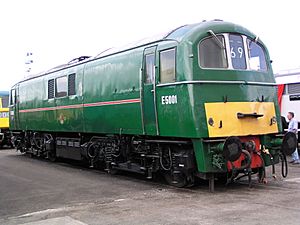British Rail Class 71 facts for kids
Quick facts for kids British Rail Class 71 |
|
 |
|
| E5001 at Doncaster Works. | |
| Power type | Electric |
|---|---|
| Builder | British Railways’ Doncaster Works |
| Build date | 1958–1960 |
| Total production | 24 |
| Configuration | Bo-Bo |
| UIC classification | Bo'Bo' |
| Gauge | 4 ft 8 1⁄2 in (1,435 mm) |
| Wheel diameter | 4 ft 0 in (1.219 m) |
| Locomotive weight | 77.00 long tons (78.24 t) |
| Electric system(s) | 660–750 V DC |
| Current collection method | Third Rail (mainline) Pantograph (sidings) |
| Traction motors | English Electric 532, 4 off |
| Top speed | 90 mph (145 km/h) |
| Power output | One-hour: 2,700 hp (2,010 kW) Continuous: 2,300 hp (1,720 kW) |
| Tractive effort | 43,800 lbf (195,000 N) |
| Train heating | Electric Train Heating |
| Locomotive brakeforce | 68 long tons-force (678 kN) |
| Train brakes | Dual Vacuum and Air |
| Career | British Railways |
| Number | E5000–E5023; later E5001–E5024; later 71001–71014 |
| Axle load class | Route availability 6 |
| Disposition | 10 rebuilt to class 74, 13 scrapped, 1 preserved |
The British Rail Class 71 was a type of electric locomotive used on the Southern part of British Railways. These powerful trains were special because they could only run on tracks that had an electric "third rail" system. This meant they couldn't travel on lines that didn't have this special power source.
Contents
Meet the Class 71 Train
The Class 71 was an electric train, meaning it ran on electricity instead of diesel fuel or steam. It was built for the Southern Region of British Railways, which had a unique way of powering its trains. Instead of overhead wires, they used a "third rail" on the ground next to the main tracks to supply electricity.
How the Class 71 Got Power
The Class 71 locomotives collected their power from a "third rail." This rail carried 660 to 750 volts of DC electricity. They had special shoes that slid along this rail to pick up the power. When they were in train yards or sidings, they could also use a pantograph, which is an arm that connects to overhead wires, but this was only for slow movements.
Speed and Strength
These locomotives were quite fast for their time, able to reach a top speed of 90 mph. They had a lot of power, about 2,700 hp, which helped them pull long and heavy passenger trains. Each Class 71 weighed about 77 tons.
Building and Using the Class 71
The Class 71 locomotives were built by British Railways at their Doncaster Works factory.
When They Were Built
Production of these trains started in 1958 and finished in 1960. In total, 24 of these locomotives were made. Each one was given a number, starting with E5000 up to E5023. Later, their numbers changed to E5001–E5024, and then some were renumbered again to 71001–71014.
Where They Operated
The Class 71s mainly worked on the Southern Region's main lines, pulling passenger trains. Their design was perfect for the third-rail system used in that area.
What Happened to the Class 71s?
The Class 71s had a relatively short life in their original form.
Changes and End of Service
- Rebuilt trains: Ten of the Class 71 locomotives were later changed into a different type of train called the British Rail Class 74. These new Class 74s could use both the third rail and overhead wires, making them more flexible.
- Scrapped: Sadly, 13 of the original Class 71s were eventually taken apart and scrapped.
- Preserved: Only one Class 71 locomotive has been saved and preserved. This means it is kept in a museum or special collection so people can still see it today.

